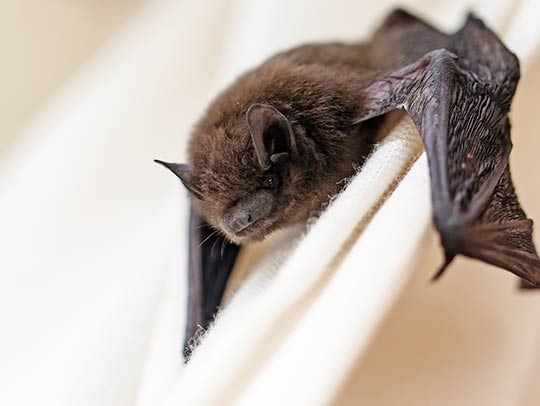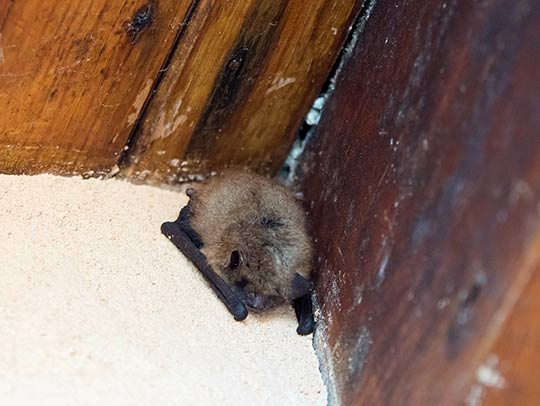Bats are essential for Florida’s ecosystem but not welcome in your home or business. Whether they’re nesting on your roof eaves or swooping around your kitchen, their presence can send shivers down your spine.

Free Bat Removal Inspection
- Call Critter Control of Tampa at 813-948-0870: Protect your home or office without endangering bats.
- Service Guarantee: If bats return, we’ll provide additional removal and exclusion efforts, free of charge.
While bats may be a key part of Florida’s ecosystem, the one environment they never belong in is your home or business. From nesting on the eve of your roof to flying around your kitchen or office, bats can cause a panic with the flap of a wing.
These tiny flying mammals are typically non-aggressive, but they may bite you if you attempt to remove them on your own. A bat bite can quickly become a serious issue, as bats often carry a variety of deadly diseases, such as rabies. Avoid a trip to the emergency room by educating yourself on bats in Florida. Let the local bat removal experts from Critter Control of Tampa humanely remove and exclude bats from your home or business while keeping you safe.
Types of Bats in Florida
This guide may help you identify bats in your home or workplace, but it’s crucial to keep a safe distance from any bat you encounter. Bats are easily disturbed, and getting too close to one may lead to injuries. Call our experts to safely identify bats, or ask for our emergency 24-hour removal service.

If you are bitten by a bat, seek medical attention immediately.
Brazilian Free-tailed Bat
- Swift Flyers: These agile bats are common in Florida.
- High-Speed Hunters: They’re insectivores, zipping after bugs in the night.
Brazilian free-tailed bats are typically 3.5 inches in length, with a wingspan of 12 to 14 inches wide. They have dark brown to gray coloring and wide, black, forward-facing ears. They typically roost in caves or under bridges, but may find their way into your attic, vents, and more. Brazilian free-tailed bats also seek out areas near water with large insect populations.
Florida Bonneted Bat
- Rare and Endangered: These large bats have a distinctive bonnet-like nose.
- Protectors of Palms: They play a role in pollinating native palms.
The largest bat species found in Florida, the Florida bonneted bat is 6.5 inches in length, and has a 20-inch wingspan. Their color varies from black and brown to gray, with a white-ish band across their chests. They roost in trees and on cliffs, but due to habitat loss, often invite themselves into buildings. Despite their alarmingly large appearance, it’s crucial to avoid getting rid of Florida bonneted bats on your own—they’re considered endangered in Florida, and should always be handled by local pest experts.
Southeastern Myotis
- Tiny Insectivores: These small bats feast on insects.
- Tree Dwellers: They roost in trees and buildings.
The southeastern myotis bats are particularly tiny, ranging from 1.9 to 2 inches in size with wings measuring 11 inches wide. They’re often gray, brown, or brown-orange. Like the Mexican free-tailed bat, the myotis often roosts in caves, but may flap its way into your attic, office, or trees. They are drawn to ponds, lakes, and other bodies of water, as they feed on mosquitoes and water beetles that reproduce in them.
Signs of Bats in the Attic
Like many homeowners, you may not spend much time in your attic. As bats seek out dark, quiet areas, the lack of human activity in attics makes them prime roosting spots. If you suspect bats may have made themselves at home in your attic, keep an eye (and ear) out for the following signs:
- Quiet Roosts: Bats love dark, quiet attics—prime real estate.
- Vent Invaders: Slim bodies allow them to slip through vents. Cover those openings!
- Droppings: Look for bat droppings, or guano, on decks, window sills, and the attic floor.
- Chirping: Listen for bats’ chirping at night or in the early morning when they’re active.
- Scratching: When not flying, bats use their claws to scratch and crawl along walls.
- Stains: The grease on bats’ fur will leave a shiny stain on the areas they contact.
Bats in the Attic Vent
Due to their slim bodies, bats can easily enter your attic through the vents. Even if your roof is properly sealed, it’s crucial to fit covers over your attic vents. Not sure where to begin with bat-proofing your attic vents? Contact the local pest experts from Critter Control of Tampa for advice.
How to Prevent Bats in the Winter
Many bat species, such as the Brazilian free-tailed bat, migrate further south in the cooler seasons. However, some species, such as the Florida bonneted bat, will look for a winter home right here in the Sunshine State. Before cold weather sets in, get your home or business inspected for potential entry points that bats may take advantage of.
Get Bats Professionally and Humanely Removed
Regardless of the bat species that has flapped its way into your space, these furry flying creatures are a key part of Florida’s many ecosystems, and are often protected by state law. At Critter Control of Tampa, we’re committed to protecting your property and the bats that find their way onto it.
- Humane Techniques: We trap and exclude bats without harm.
- Effective Solutions: Netting, vent covers—we’ll prevent infestations.
- Clean Sweep: Guano and urine removal—your space will be bat-free.
We utilize humane trapping techniques for removal, and then provide you with effective exclusion solutions to prevent bats from returning. From netting to proper vent covers, it’s our mission to prevent a bat infestation before it even happens. If we do remove bats from your property, we can also remove any signs of their activity—from guano removal to urine removal, our cleaning services will make it seem as if your bat infestation never happened.
Tampa Bat Service Areas
We’re proud to offer bat solutions and services to the greater Tampa area, including:
- St. Petersburg bat removal
- Tarpon Springs bat removal
- Belleair Beach bat removal
- Palm Harbor bat removal
- Clearwater Beach bat removal
- New Tampa bat removal
- Hunters Green bat removal
- Pebble Creek bat removal
- Riverview bat removal
- Brandon bat removal
Schedule Your Free Bat Inspection with Critter Control of Tampa
Protect your home or office without endangering bats—call an expert from Critter Control of Tampa. We’re dedicated to helping residents and business owners in Tampa solve their critter problems in humane ways and return to a pest-free life.
In addition to our free inspection, valued at $299, we also offer a service guarantee. In the event that bats return, we’ll provide additional removal and exclusion efforts, free of charge. Give your local pest experts from Critter Control of Tampa a call, or contact us online to schedule your free inspection today.
FAQs About Bat Removal
Does homeowners insurance cover bat removal?
No, homeowners insurance will not cover bat removal, nor will it cover other forms of pest control or wildlife control. However, it is possible that your homeowners insurance could cover the damage left behind by bats or other pests or wildlife. Check your insurance policy to confirm if and how much it will cover wildlife damage.
When can bats be removed in Florida?
Unlike many pests and types of wildlife, bats are protected by the government’s wildlife laws in Florida. It is illegal to poison, kill, or otherwise exterminate bats. Bats can only be removed between August 14 and April 16. The summer is considered maternity season, and it is illegal to exclude bats in that time.
Therefore, you should never try to remove bats yourself in Florida. Contact the pest and wildlife control professionals at Critter Control, as our technicians are trained in safely removing bats from your property.
How much does bat removal cost?
Bat removal costs vary on the number of bats and any damage they have caused requiring repair. A simple residential bat removal job can cost only a few hundred dollars. If attic insulation is soiled and multiple access points have been created, costs can be in the thousands for attic insulation removal, cleaning of bat guano, sanitizing, and insulation replacement.
Your Critter Control certified wildlife technician will provide a detailed estimate and review it with you prior to performing any work.





